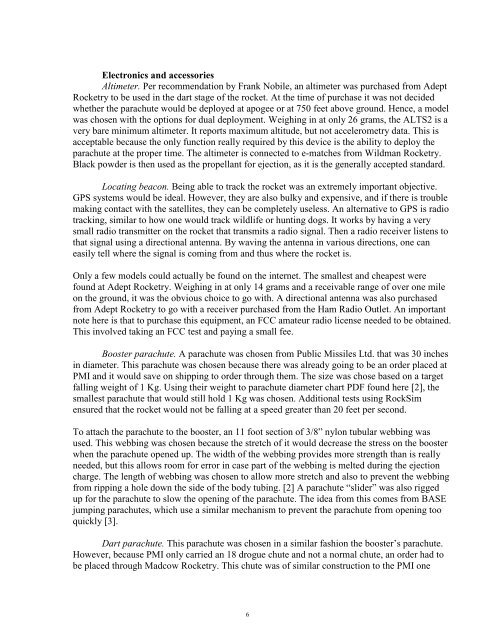Space Grant Consortium - University of Wisconsin - Green Bay
Space Grant Consortium - University of Wisconsin - Green Bay
Space Grant Consortium - University of Wisconsin - Green Bay
You also want an ePaper? Increase the reach of your titles
YUMPU automatically turns print PDFs into web optimized ePapers that Google loves.
Electronics and accessories<br />
Altimeter. Per recommendation by Frank Nobile, an altimeter was purchased from Adept<br />
Rocketry to be used in the dart stage <strong>of</strong> the rocket. At the time <strong>of</strong> purchase it was not decided<br />
whether the parachute would be deployed at apogee or at 750 feet above ground. Hence, a model<br />
was chosen with the options for dual deployment. Weighing in at only 26 grams, the ALTS2 is a<br />
very bare minimum altimeter. It reports maximum altitude, but not accelerometry data. This is<br />
acceptable because the only function really required by this device is the ability to deploy the<br />
parachute at the proper time. The altimeter is connected to e-matches from Wildman Rocketry.<br />
Black powder is then used as the propellant for ejection, as it is the generally accepted standard.<br />
Locating beacon. Being able to track the rocket was an extremely important objective.<br />
GPS systems would be ideal. However, they are also bulky and expensive, and if there is trouble<br />
making contact with the satellites, they can be completely useless. An alternative to GPS is radio<br />
tracking, similar to how one would track wildlife or hunting dogs. It works by having a very<br />
small radio transmitter on the rocket that transmits a radio signal. Then a radio receiver listens to<br />
that signal using a directional antenna. By waving the antenna in various directions, one can<br />
easily tell where the signal is coming from and thus where the rocket is.<br />
Only a few models could actually be found on the internet. The smallest and cheapest were<br />
found at Adept Rocketry. Weighing in at only 14 grams and a receivable range <strong>of</strong> over one mile<br />
on the ground, it was the obvious choice to go with. A directional antenna was also purchased<br />
from Adept Rocketry to go with a receiver purchased from the Ham Radio Outlet. An important<br />
note here is that to purchase this equipment, an FCC amateur radio license needed to be obtained.<br />
This involved taking an FCC test and paying a small fee.<br />
Booster parachute. A parachute was chosen from Public Missiles Ltd. that was 30 inches<br />
in diameter. This parachute was chosen because there was already going to be an order placed at<br />
PMI and it would save on shipping to order through them. The size was chose based on a target<br />
falling weight <strong>of</strong> 1 Kg. Using their weight to parachute diameter chart PDF found here [2], the<br />
smallest parachute that would still hold 1 Kg was chosen. Additional tests using RockSim<br />
ensured that the rocket would not be falling at a speed greater than 20 feet per second.<br />
To attach the parachute to the booster, an 11 foot section <strong>of</strong> 3/8” nylon tubular webbing was<br />
used. This webbing was chosen because the stretch <strong>of</strong> it would decrease the stress on the booster<br />
when the parachute opened up. The width <strong>of</strong> the webbing provides more strength than is really<br />
needed, but this allows room for error in case part <strong>of</strong> the webbing is melted during the ejection<br />
charge. The length <strong>of</strong> webbing was chosen to allow more stretch and also to prevent the webbing<br />
from ripping a hole down the side <strong>of</strong> the body tubing. [2] A parachute “slider” was also rigged<br />
up for the parachute to slow the opening <strong>of</strong> the parachute. The idea from this comes from BASE<br />
jumping parachutes, which use a similar mechanism to prevent the parachute from opening too<br />
quickly [3].<br />
Dart parachute. This parachute was chosen in a similar fashion the booster’s parachute.<br />
However, because PMI only carried an 18 drogue chute and not a normal chute, an order had to<br />
be placed through Madcow Rocketry. This chute was <strong>of</strong> similar construction to the PMI one<br />
6

















